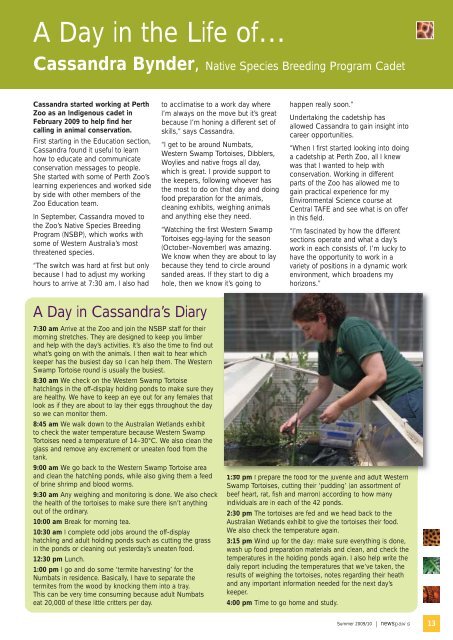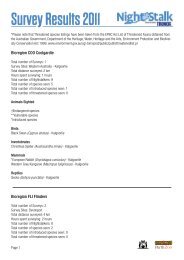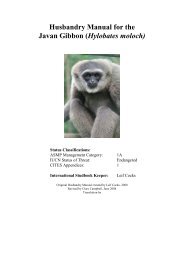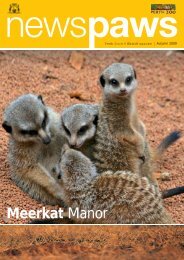Summer 2009 - Perth Zoo
Summer 2009 - Perth Zoo
Summer 2009 - Perth Zoo
Create successful ePaper yourself
Turn your PDF publications into a flip-book with our unique Google optimized e-Paper software.
A Day in the Life of…<br />
Cassandra Bynder, Native Species Breeding Program Cadet<br />
Cassandra started working at <strong>Perth</strong><br />
<strong>Zoo</strong> as an Indigenous cadet in<br />
February <strong>2009</strong> to help find her<br />
calling in animal conservation.<br />
First starting in the Education section,<br />
Cassandra found it useful to learn<br />
how to educate and communicate<br />
conservation messages to people.<br />
She started with some of <strong>Perth</strong> <strong>Zoo</strong>’s<br />
learning experiences and worked side<br />
by side with other members of the<br />
<strong>Zoo</strong> Education team.<br />
In September, Cassandra moved to<br />
the <strong>Zoo</strong>’s Native Species Breeding<br />
Program (NSBP), which works with<br />
some of Western Australia’s most<br />
threatened species.<br />
“The switch was hard at first but only<br />
because I had to adjust my working<br />
hours to arrive at 7:30 am. I also had<br />
A Day in Cassandra’s Diary<br />
7:30 am Arrive at the <strong>Zoo</strong> and join the NSBP staff for their<br />
morning stretches. They are designed to keep you limber<br />
and help with the day’s activities. It’s also the time to find out<br />
what’s going on with the animals. I then wait to hear which<br />
keeper has the busiest day so I can help them. The Western<br />
Swamp Tortoise round is usually the busiest.<br />
8:30 am We check on the Western Swamp Tortoise<br />
hatchlings in the off-display holding ponds to make sure they<br />
are healthy. We have to keep an eye out for any females that<br />
look as if they are about to lay their eggs throughout the day<br />
so we can monitor them.<br />
8:45 am We walk down to the Australian Wetlands exhibit<br />
to check the water temperature because Western Swamp<br />
Tortoises need a temperature of 14–30°C. We also clean the<br />
glass and remove any excrement or uneaten food from the<br />
tank.<br />
9:00 am We go back to the Western Swamp Tortoise area<br />
and clean the hatchling ponds, while also giving them a feed<br />
of brine shrimp and blood worms.<br />
9:30 am Any weighing and monitoring is done. We also check<br />
the health of the tortoises to make sure there isn’t anything<br />
out of the ordinary.<br />
10:00 am Break for morning tea.<br />
10:30 am I complete odd jobs around the off-display<br />
hatchling and adult holding ponds such as cutting the grass<br />
in the ponds or cleaning out yesterday’s uneaten food.<br />
12:30 pm Lunch.<br />
1:00 pm I go and do some ‘termite harvesting’ for the<br />
Numbats in residence. Basically, I have to separate the<br />
termites from the wood by knocking them into a tray.<br />
This can be very time consuming because adult Numbats<br />
eat 20,000 of these little critters per day.<br />
to acclimatise to a work day where<br />
I’m always on the move but it’s great<br />
because I’m honing a different set of<br />
skills,” says Cassandra.<br />
“I get to be around Numbats,<br />
Western Swamp Tortoises, Dibblers,<br />
Woylies and native frogs all day,<br />
which is great. I provide support to<br />
the keepers, following whoever has<br />
the most to do on that day and doing<br />
food preparation for the animals,<br />
cleaning exhibits, weighing animals<br />
and anything else they need.<br />
“Watching the first Western Swamp<br />
Tortoises egg-laying for the season<br />
(October–November) was amazing.<br />
We know when they are about to lay<br />
because they tend to circle around<br />
sanded areas. If they start to dig a<br />
hole, then we know it’s going to<br />
happen really soon.”<br />
Undertaking the cadetship has<br />
allowed Cassandra to gain insight into<br />
career opportunities.<br />
“When I first started looking into doing<br />
a cadetship at <strong>Perth</strong> <strong>Zoo</strong>, all I knew<br />
was that I wanted to help with<br />
conservation. Working in different<br />
parts of the <strong>Zoo</strong> has allowed me to<br />
gain practical experience for my<br />
Environmental Science course at<br />
Central TAFE and see what is on offer<br />
in this field.<br />
“I’m fascinated by how the different<br />
sections operate and what a day’s<br />
work in each consists of. I’m lucky to<br />
have the opportunity to work in a<br />
variety of positions in a dynamic work<br />
environment, which broadens my<br />
horizons.”<br />
1:30 pm I prepare the food for the juvenile and adult Western<br />
Swamp Tortoises, cutting their ‘pudding’ (an assortment of<br />
beef heart, rat, fish and marron) according to how many<br />
individuals are in each of the 42 ponds.<br />
2:30 pm The tortoises are fed and we head back to the<br />
Australian Wetlands exhibit to give the tortoises their food.<br />
We also check the temperature again.<br />
3:15 pm Wind up for the day: make sure everything is done,<br />
wash up food preparation materials and clean, and check the<br />
temperatures in the holding ponds again. I also help write the<br />
daily report including the temperatures that we’ve taken, the<br />
results of weighing the tortoises, notes regarding their heath<br />
and any important information needed for the next day’s<br />
keeper.<br />
4:00 pm Time to go home and study.<br />
<strong>Summer</strong> <strong>2009</strong>/10 | newspaw s<br />
13






